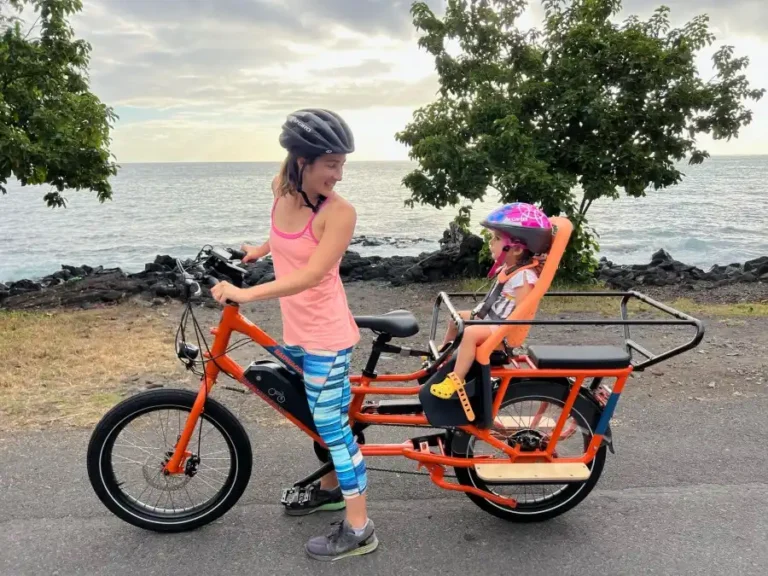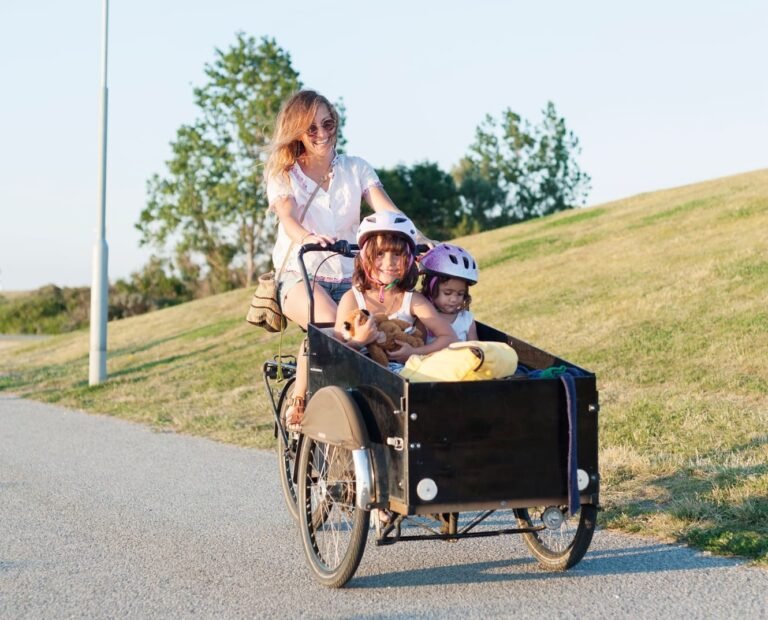Tavarapyörän rungon geometrialla on keskeinen rooli polkupyörän käyttäytymisessä erilaisissa ajo-olosuhteissa. Tämä on erityisen tärkeää tavarapyörille, jotka on suunniteltu kuljettamaan huomattavia kuormia säilyttäen samalla turvallisuuden, tasapainon ja helpon hallinnan. Toisin kuin tavalliset polkupyörät, tavarapyörät vaativat erityisiä geometrisia ja rakenteellisia huomioita sen varmistamiseksi, että ne pysyvät vakaina ja hallittavina, erityisesti kaupunkiympäristöissä, joissa tilaa on rajoitetusti ja ohjattavuus on olennaista.
Tässä artikkelissa tarkastellaan, miten rungon geometria vaikuttaa tavarapyörän suorituskykyyn, mitkä tekijät vaikuttavat käsiteltävyyteen, miten nämä tekijät ovat vuorovaikutuksessa, vaikuttavatko materiaalit geometriseen suunnitteluun ja mitä kehityskulkuja tavarapyörien suunnittelussa on odotettavissa tulevaisuudessa.
Rooli rahtipyörä Rungon geometria tavarapyörän suunnittelussa
Polkupyöräsuunnittelussa geometria viittaa rungon eri osien välisiin tilallisiin kokoonpanoihin ja kulmasuhteisiin. Keskeisiä elementtejä ovat pään putken kulma, akseliväli, jälkijännitys, satulaputken kulma ja keskiön korkeus. Tavarapyörissä nämä parametrit on räätälöitävä paitsi ajomukavuuden ja työntövoiman tehokkuuden myös raskaiden ja joskus epätasaisesti jakautuneiden kuormien tukemiseksi.
Esimerkiksi pitkä akseliväli – tyypillinen ominaisuus monille tavarankuljetuspyörille – voi parantaa vakautta, erityisesti kuormattuna. Pidempi runko voi kuitenkin heikentää ohjattavuutta ahtaissa tiloissa. Ohjaamon pään kulma vaikuttaa pyörän ohjautumiseen; löysempi kulma johtaa vakaampaan ohjattavuuteen, mikä on toivottavaa tavaran kuljetuksessa, kun taas jyrkempi kulma tarjoaa herkemmän ohjauksen, mutta voi tuntua epävakaalta raskasta kuormaa kuljetettaessa. Jälki, joka määritellään vaakasuoraksi etäisyydeksi etupyörän kosketuspisteestä maahan ohjausakselin ja maan leikkauspisteeseen, vaikuttaa myös vakauteen. Korkeammat jäljen arvot johtavat tyypillisesti ohjauksen itsekeskittyvämpään käyttäytymiseen, mikä voi olla hyödyllistä pyörille, joissa kuljetetaan eteen lastattua tavaraa.
Kuorman tarkka sijainti – olipa se sitten kuljettajan edessä (kuten pitkäperämalleissa) tai takana (kuten pitkäperämalleissa) – on toinen geometrinen huomioon otettava seikka. Mitä kauemmas massa sijoitetaan kuljettajasta, sitä suurempi on sen mahdollinen vaikutus käsiteltävyyteen ja ohjausdynamiikkaan. Suunnittelijat reagoivat usein muuttamalla ohjausgeometriaa tai vahvistamalla rakenneosia vähentääkseen vääntöjännitystä kuormituksen alaisena.
Keskeiset tekijät, jotka vaikuttavat tavarapyörien käsittelyyn
Rahtipyörien ajettavuuteen vaikuttavat geometristen tekijöiden, mekaanisten ominaisuuksien ja dynaamisten vasteiden monimutkainen vuorovaikutus. Rahtipyörien yleistyessä kaupunkiympäristöissä näiden tekijöiden ymmärtäminen voi auttaa sekä suunnittelupäätöksissä että käyttötavoissa. Seuraavaksi syvennymme kriittisiin elementteihin, jotka muokkaavat rahtipyörien käyttäytymistä tiellä:
1. Kuorman jakautuminen ja painopiste
- Tehokas tavarapyörän käsittely riippuu suuresti kuorman jakautumisesta. Tarkemmin sanottuna painopisteen sijainti ja korkeus määräävät merkittävästi polkupyörän tasapainon ja reagointikyvyn:
- Pystysuora kuorman sijoitteluKorkealle asennetut kuormat vaikuttavat negatiivisesti vakauteen nostamalla painopistettä. Mitä korkeammalle kuorma sijoitetaan, sitä suurempi on pyörän kaatumisriski, mikä on erityisen havaittavissa hitailla nopeuksilla tai tiukoissa käännöksissä ajettaessa. Pyöräilijöiden tulisi pyrkiä sijoittamaan raskaammat esineet alemmas ja lähemmäs runkoa vakauden parantamiseksi.
- Edestä vs. takaa lastausEtukuormattavilla tavarapyörillä on erityiset ajo-ominaisuudet johtuen massan jakautumisesta ohjausakselin edessä. Tämä kokoonpano voi aiheuttaa huomattavan viiveen ohjausvasteessa lisääntyneen inertian vuoksi ohjaustankoa käännettäessä. Kuljettajat kuvailevat tätä tunnetta tyypillisesti hitaaksi tai vähemmän intuitiiviseksi, mikä edellyttää ajotyylin säätämistä tai jopa lisäohjausvivustojen asentamista vaikutuksen lieventämiseksi.
2. Rungon joustavuus ja jäykkyys
- Rungon muotoilu vaikuttaa merkittävästi ajettavuuteen, erityisesti rahtipyörissä, jotka altistuvat huomattavalle painolle ja vaihteleville maasto-olosuhteille:
- Optimaalinen jäykkyysSopivan jäykkä runkorakenne kompensoi tehokkaasti kaarteissa, jarrutuksissa ja epätasaisissa tieolosuhteissa syntyviä vääntövoimia ja tarjoaa ennustettavan ja tarkan käsiteltävyyden kuormitettuna. Suunnittelijat pyrkivät rakenteelliseen jäykkyyteen, jotta reagointikyky säilyy tinkimättä liikaa mukavuudesta.
- Joustavuuden ja mukavuuden välinen kompromissiLiian jäykkä runko voi kuitenkin välittää tien tärinää suoraan ajajalle, mikä voi aiheuttaa epämukavuutta ja väsymystä pitkillä matkoilla. Huolellisesti suunniteltu tasapaino jäykkyyden ja mukavuuden välillä takaa paremman ajokokemuksen.
3. Ohjausgeometria
- Rahtipyörän ohjausjärjestelmän geometria vaikuttaa merkittävästi ajokäyttäytymiseen:
- Trail- ja head tube -kulmaJälki – ohjausakselin linjan ja renkaan kosketuspinnan välinen vaakasuora etäisyys – ja emäputken kulma vaikuttavat suoraan ohjausdynamiikkaan. Pyörät, joilla on suurempi jälki, tuntuvat usein vakaammilta suurilla nopeuksilla, mutta voivat vaatia enemmän vaivaa pienemmillä nopeuksilla. Toisaalta lyhyempi jälki johtaa nopeampaan ja helpompaan ohjattavuuteen pienillä nopeuksilla, mutta voi tuntua yliherkältä tai epävakaalta suuremmilla nopeuksilla.
- Ohjausvivustot Long JohnsissaPitkät tavaratelineet – joissa on pidennetty etukuormausalusta – käyttävät usein vivusto-ohjausjärjestelmiä. Tällaiset järjestelmät auttavat kompensoimaan pidennettyjen runkojen aiheuttamaa lisähitautta ja viivettä varmistaen, että ohjaustangon kääntäminen pysyy intuitiivisena ja ennustettavana eteenpäin siirtyneestä kuormasta huolimatta.
4. Renkaan koko ja tyyppi
- Rengasvalinnat vaikuttavat ajomukavuuteen, tavaratilan käytännöllisyyteen ja yleiseen käsiteltävyyteen:
- Pienemmät etupyörätEtukuormaavissa tavarapyörissä käytetään yleensä pienempiä pyöriä (yleensä noin 20 tuumaa), jotta tavaratilat ovat matalammat, mikä yksinkertaistaa lastaus- ja purkutehtäviä. Vaikka pienemmät pyörät ovat hyödyllisiä lastin saavutettavuuden ja vakauden kannalta alemmilla korkeuksilla, niiden vierintätehokkuus on hieman heikentynyt, mikä on erityisen havaittavissa epätasaisilla pinnoilla ajettaessa.
- Renkaan leveys ja paineRengasvalinta on ratkaisevan tärkeää, sillä leveämmät renkaat optimaalisella paineella parantavat pitoa, iskunvaimennusta ja vakautta, mikä vaikuttaa merkittävästi käsiteltävyyteen. Korkeampi paine voi parantaa tehokkuutta ja vähentää vierintävastusta, mutta vaimentaa vähemmän töyssyissä, mikä voi vaikuttaa ajomukavuuteen ja lastin vakauteen.
5. Jousituselementit
- Jousitusjärjestelmien käyttöönotto tarjoaa huomattavia etuja dynaamiseen käsittelyyn, erityisesti vaihtelevia ja raskaita kuormia kuljetettaessa:
- Parempi vakaus ja mukavuusEtu- ja takajousitusjärjestelmät auttavat hallitsemaan dynaamisia kuormia vaimentamalla iskuja ja tärinää epätasaisilla pinnoilla, mikä ylläpitää pyörän ja maan välistä kosketusta, parantaa pitoa ja lisää ajomukavuutta. Tehokkaat jousitusratkaisut tasapainottavat suurempien iskunvaimennusta ja minimoivat samalla liiallisen pomppimisen tai energianhukan.
- KompromissitJousituksen käyttöönotto lisää väistämättä monimutkaisuutta ja huoltotarvetta sekä tyypillisesti painoa ja kustannuksia. Suunnittelijoiden ja käyttäjien on siksi tasapainotettava jousituksen edut käytännön näkökohtien kanssa, jotka koskevat yksinkertaisuuden, kohtuuhintaisuuden ja luotettavuuden ylläpitämistä käyttötarkoitusten perusteella.
6. Ajoasento ja ergonomia
- Ajajan asento vaikuttaa olennaisesti painon jakautumiseen polkupyörän yli ja siten myös ohjattavuuteen:
- Satulan korkeus ja ulottuvuusSatulan oikean korkeuden ja ulottuvuuden säädöt asettavat ajajan optimaalisesti tehokkaan polkemisen ja hallitun käsittelyn takaamiseksi. Satulan väärä sijoitus voi johtaa epätasaiseen painonjakaumaan, mikä voi aiheuttaa liiallista etu- tai takapyörän painotusta, heikentynyttä pitoa ja heikentynyttä ohjattavuutta.
- Ohjaustangon sijainti ja tyyliErgonomisesti sijoitetut ohjaustangot vaikuttavat myös kuljettajan asentoon ja vakauteen. Mukava ja intuitiivinen käsiasento antaa kuljettajille mahdollisuuden hallita ohjausliikkeitä tarkasti ja säilyttää tasapaino, mikä on erityisen tärkeää raskaasti kuormitettujen tavarapyörien kuljettamisessa ruuhkaisilla kaupunkialueilla tai epätasaisilla teillä.
Vaikuttavatko nämä tekijät toisiinsa?
Kyllä, merkittävästi – ja näiden ymmärtäminen keskinäiset riippuvuudet on elintärkeää.
| Tekijä 1 | Tekijä 2 | Vuorovaikutus |
| Geometria (pääputken kulma) | Polku | Yhdessä ne määrittelevät ohjaustuntuman. Jyrkempi ohjauskulma ja matala jälki johtavat nykivään ohjaukseen. |
| Kuorman sijoittelu | Rungon jäykkyys | Joustavan rungon raskaat etukuormat voivat johtaa rungon heilumiseen jarrutettaessa tai kaarteissa. |
| Akseliväli | Kääntösäde | Pidempi akseliväli parantaa suoraviivaisuutta, mutta heikentää kääntymisen terävyyttä. |
| Materiaali | Jäykkyys | Alumiini voi tehdä ajosta kevyemmän mutta jäykemmän; teräs lisää joustavuutta, mikä muuttaa rungon käyttäytymistä kuormituksen alla. |
”Nämä parametrit eivät ole pelkästään additiivisia – ne yhdistyvät tavoilla, jotka muuttavat perustavanlaatuisesti pyörän tuntumaa ja turvallisuutta kuormausolosuhteissa.” — (Dell'Orto ym., 2025)
Siksi insinöörien on lähestyttävä tavarapyörien suunnittelua kokonaisvaltaisesti, ei pala palalta.
Keskinäisriippuvuus ja yhteisvaikutukset
Rahtipyörän käsiteltävyyteen vaikuttavat eri tekijät toimivat harvoin erikseen. Sen sijaan ne ovat vuorovaikutuksessa tavoilla, jotka voivat joko vahvistaa tai heikentää niiden yksittäisiä vaikutuksia. Esimerkiksi pidempi akseliväli voi parantaa suoraviivaista vakautta, mutta se voi pahentaa joustavan rungon tai huonosti jakautuneen kuorman aiheuttamia käsittelyhaasteita. Samoin renkaan leveyden valinta vaikuttaa paitsi mukavuuteen ja pitoon, myös vuorovaikutuksessa ajon ja ohjainkannattimen kulman kanssa, mikä muokkaa ohjauskäyttäytymistä.
Geometrian yhden osan muutokset voivat edellyttää kompensoivia säätöjä muualla. Esimerkiksi keskiölaakerin madaltaminen tasapainon parantamiseksi voi myös vähentää poljinvälystä käännöksissä, mikä edellyttää muutoksia kampivarren pituuteen tai rungon muotoon. Nämä vuorovaikutukset korostavat sekä vakauden että ohjattavuuden suunnittelun monimutkaisuutta yhdelle alustalle.
Kuorman vaikutus muuttuu myös riippuen siitä, onko paino staattinen vai dynaaminen. Kun ajaja kääntyy, kiihdyttää tai jarruttaa, kuorman sijainti ohjausakseliin nähden ja rungon vääntöjäykkyys vaikuttavat siihen, miten polkupyörä reagoi. Siksi tarvitaan järjestelmätason lähestymistapaa, jossa geometria, materiaalit, ajajan asento ja odotettu kuorman käyttö otetaan kaikki huomioon yhdessä suunnitteluprosessissa.
Materiaalien vaikutus geometriaan ja suorituskykyyn
Rakennusmateriaalin valinnalla on suora vaikutus erilaisten runkogeometrioiden toteutettavuuteen ja suorituskykyyn. Materiaalien mekaaniset ominaisuudet – kuten jäykkyys, väsymiskestävyys, venyvyys ja tiheys – vaihtelevat, ja nämä ominaisuudet vaikuttavat sekä rungon muotoon että käyttäytymiseen.
Alumiinia käytetään usein tavarapyörissä sen keveyden ja korroosionkestävyyden vuoksi. Sen alhaisempi kimmokerroin verrattuna teräkseen tarkoittaa kuitenkin, että alumiinirunkoisissa on käytettävä paksumpia tai suurempihalkaisijaisia putkia riittävän jäykkyyden saavuttamiseksi. Tämä voi rajoittaa geometrista joustavuutta ja aiheuttaa painorajoituksia tietyillä alueilla.
Teräs, erityisesti erittäin lujat kromi-molybdeeniseokset, tarjoaa erinomaisen väsymiskestävyyden ja mahdollistaa hoikemmat runkopalkit, mikä voi olla eduksi monimutkaisissa geometrioissa tai esteettisissä malleissa. Sen suurempi elastisuus voi tarjota tasaisemman ajon, mutta se on yleensä painavampaa kuin alumiini.
Hiilikuitua on käytetty harvoin tavarapyörien rakentamisessa sen kustannusten ja heikon iskunkestävyyden vuoksi. Se tarjoaa kuitenkin vertaansa vailla olevan jäykkyys-painosuhteen ja saattaa tulevaisuudessa muuttua käyttökelpoisemmaksi tietyissä korkean suorituskyvyn sovelluksissa.
Kokeellisia materiaaleja, kuten laminoitua puuta, on myös tutkittu, pääasiassa niiden tärinänvaimennusominaisuuksien ja kestävyyden vuoksi. Kestävyyteen, liitosominaisuuteen ja pitkäaikaiseen lujuuteen kuormituksen alla liittyvät haasteet ovat kuitenkin edelleen olemassa.
Materiaalivalinnat vaikuttavat siis geometriaan paitsi suorien mekaanisten rajoitusten myös valmistukseen liittyvien rajoitusten ja taloudellisten näkökohtien kautta. Ihanteellisen materiaalin on tuettava vaadittua runkogeometriaa vaarantamatta lujuutta tai ajomukavuutta.
Vaikuttaako materiaali rungon geometriaan?
Ehdottomasti. Materiaaliominaisuudet, kuten Youngin moduuli, myötölujuus, väsymiskestävyys ja valmistusrajoitukset vaikuttavat suoraan rungon geometriaan ja suunnittelupäätöksiin.
Yleiset materiaalit ja niiden vaikutukset
| Materiaali | Vaikutus geometriaan |
| Alumiini | Kevyt ja jäykkä. Vaatii suurempia putkihalkaisijoita taipumisen estämiseksi. Johtaa usein kulmikkaampiin runkorakenteisiin. |
| Teräs (CroMo) | Korkea väsymiskestävyys, anteeksiantavampi ajo. Mahdollistaa ohuemmat putket ja orgaanisemmat muodot. |
| hiilikuitu | Ei yleisesti käytetty rahtipyörissä kustannus- ja vaurioherkkyyden vuoksi. Mutta mahdollinen tietyissä erikoissovelluksissa. |
| Puu | Kokeellisesti tutkittu. Vaimentaa tärinää, mutta liitosten ja kestävyyden suhteen on edelleen haasteita. (Taylor, 2016) |
Pohjimmiltaan materiaalin valinta asettaa rajoituksia sille, millainen geometria voidaan turvallisesti saavuttaa halutun suorituskyvyn säilyttäen.
Näkymät ja tulevaisuuden kehitys
Tavarapyörien tullessa yhä keskeisemmäksi osaksi kaupunkiliikennettä ja jakelupalveluita, niiden suunnittelu kehittyy edelleen. Useita nousevia trendejä on jo havaittavissa sekä kaupallisissa prototyypeissä että akateemisessa tutkimuksessa.
Yksi odotettavissa oleva kehitysaskel on modulaaristen tai säädettävien geometrioiden käyttöönotto. Rungot, joita voidaan pidentää tai supistaa erilaisten lastikokoonpanojen mukaan, tarjoaisivat joustavuutta käyttäjille, joilla on erilaiset kuljetustarpeet. Tämä voi sisältää myös integroinnin taittomekanismeihin helpottamaan varastointia.
Toinen todennäköinen suunta on simulointityökalujen suurempi integrointi suunnitteluprosessiin. Elementtimenetelmämallinnus ja dynaaminen simulointi antavat suunnittelijoille mahdollisuuden testata ja optimoida geometriaa digitaalisesti ennen prototyyppien luomista, mikä vähentää merkittävästi kehitysaikaa ja -kustannuksia.
Sähköisten avustusjärjestelmien laajan käyttöönoton myötä myös tavarapyörien geometriat muuttuvat suurempien keskinopeuksien ja pidemmän toimintasäteen saavuttamiseksi. Tämä edellyttää entistä suurempaa huomiota vakauteen ja hallintaan, erityisesti suurilla nopeuksilla tai epätasaisessa maastossa.
Lopuksi odotetaan lisääntyvää erikoistumista tavarapyörien suunnitteluun. Aivan kuten maastopyörät, maantiepyörät ja työmatkapyörät ovat eronneet toisistaan geometrian ja runkorakenteen suhteen, tavarapyöriä saatetaan pian räätälöidä tarkemmin kaupunkiläheteille, perhekuljetuksille tai teollisuuden logistiikalle, joilla kullakin on ainutlaatuiset käsittely- ja rakennevaatimukset.
Johtopäätös
Tavarapyörien rungon geometria on olennainen osa niiden suorituskykyä, erityisesti vaihtelevissa kuormitusolosuhteissa tapahtuvan käsittelyn kannalta. Parametrit, kuten akseliväli, ohjainputken kulma, jälki ja keskiölaatikon korkeus, on valittava huolellisesti ja tasapainotettava suunnitellun lastin sijoittelun ja polkupyörän dynaamisen käyttäytymisen kanssa.
Nämä geometriset ominaisuudet eivät toimi erillään, vaan ne ovat vuorovaikutuksessa materiaalien ominaisuuksien, kuljettajan asennon ja mekaanisten komponenttien kanssa määrittäen pyörän vakauden, ohjattavuuden ja mukavuuden. Tavarapyörien yleistyessä kaupungeissa ja teollisuudessa tarkan, sovelluskohtaisen geometrian tarve vain kasvaa. Tulevaisuuden suunnittelun odotetaan sisältävän uusia materiaaleja, digitaalisia mallinnustyökaluja ja mukautuvia komponentteja, jotta voidaan vastata nykyaikaisen liikenteen kehittyviin vaatimuksiin.
Viitteet
Vrignaud, R., Köckritz, J., Nepp, R. (2024). Tavarapyörien dynaaminen käyttäytyminen: Lähestymistapa kvantitatiiviseen arviointiin. TechMech-lehti.
Dell'Orto, G., Mastinu, G., Happee, R. (2025). Kaupunki- ja rahtipyörien renkaiden sivuttaisominaisuuksien mittaus. Ajoneuvojärjestelmän dynamiikka, Taylor & Francis.
Williams, T. (2015). Rungon jäykkyyden ja ajajan asennon vaikutus polkupyörän dynamiikkaan: analyyttinen tutkimusProQuest-väitöskirja.
Slaets, P., Demeester, E., Juwet, M. (2022). Joustavassa Delta-kolmipyörässä käytetyn vääntöjousen vaikutukset. Sovellettu mekaniikka, MDPI.
Minter, D. (2022). Kehykset ja materiaalitSisään Routledge-pyöräilyn opasRoutledge.
Taylor, B. (2016). Puun ja sen johdannaisten toteutettavuus polkupyörän rungon rakennusmateriaalina. Universitat Politècnica de València.
Kooijman, JDG, Schwab, AL (2011). Katsaus polkupyörän ja moottoripyörän käsittelyominaisuuksiin. Kansainvälinen suunnittelutekniikan konferenssi.
Paudel, M., Yap, FF (2024). Polkupyörän geometrian ja kuorman vaikutuksen analysointi tavarapyörien ajettavuuteen ja turvallisuuteen. Heliyon, Elsevier. https://www.cell.com/heliyon/fulltext/S2405-8440(24)05555-5
Naumov, V. (2021). Sähkökäyttöisten tavarapyörien lastauskeskuksen sijainnin perustelu. Energiat, MDPI. https://www.mdpi.com/1996-1073/14/4/839






